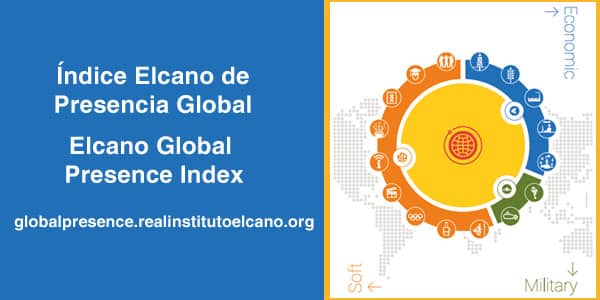
Today at the Elcano Royal Institute we present our new Global Presence website, concluded very satisfactorily with Geographica. For 13 months Ivanosca and Ángel have focused on developing the website, Carola has fine-tuned the content (what is it, documents and publications, news and FAQs) and Manuel (our data cruncher) has worn himself to the bone unbundling the global presence data series to reach the first of the entries with which the index is calculated. Manuel’s work has been necessary in order to develop the data section as in this new tool they are the result of an engine incorporated to the webpage that calculates the global presence results online –index value, position in the ranking, shares and contributions– based on the entry data taken from international data sources. We thereby generate global presence data with a tool that significantly minimises the risk of errors.
And what’s it all for? Global presence, that ‘obscure object of desire’…
When the project kicked off in 2008, Ignacio and Iliana frequently came up against the following (non-rhetorical) question: ‘all these calculations are fine but what on earth are you measuring?’. We’ve defined global presence as a country’s projection beyond its borders in three dimensions –economic, military and soft–. However, it’s possibly easier to understand by explaining that the global presence index calculates to what degree countries are ‘out there’. And our insistence on making the calculation is because we believe that in the current context of globalisation a concept like global presence can be more useful than others –power, for instance– for analysing international relations. An increasing number of countries –from Vietnam to Angola– are seeking to project themselves abroad but not all of them are necessarily following a regional or global power or influence agenda.
In any case, global presence is a new concept, still little used in the analysis of international relations and that, contrary to development or power, for instance, cannot speak for itself. Hence, global presence required a tool to help it speak. But speak of what? We believe the index is useful for two kinds of analyses.
Global trends in international relations – shares and ranking
First, the index allows us to analyse global trends in international relations. The website incorporates a ranking tool that orders countries according to their global presence index value. The trends can be observed because it shows us how values and positions have changed over the entire period under study (1990-2013). Thus, we can rapidly and easily see, for instance, that the United States is in the lead in global presence or that China has climbed nine places –from 13th to 4th– in little more than 20years.
Imagine a large-scale global presence pie-chart –the sum of the global presence of all the countries for which the index is calculated–: what does it look like?, and how is it shared out? The pie has gradually grown as countries –from Asia, Africa and Latin America– have gradually joined the globalisation process. Of course, not all countries increase their presence at the same rate –eg, China’s has not grown in line with Belgium’s, for instance–, so their global presence shares also vary.
Thus, despite the absolute growth in the global presence of the United States its share has dropped from 23.54% in 1990 to 15.64% in 2013, while China’s has grown from 1.44% to 5% over the same period. This leads to an interesting debate about whether the world is heading towards a new bipolarity or towards a multipolar, unipolar or even apolar system.
How do countries project themselves abroad? The country factsheets and contributions tools for analysing foreign policy and action abroad
Furthermore, the country factsheet also provides the key characteristics of a country’s projection abroad: which dimension –economic, military or soft– contributes to a greater degree to its global presence, what variables shape each of the dimensions –manufactures in the economic dimension, capabilities in the military and culture in the soft, etc– and how they have evolved over the years. It is therefore a useful tool for analysis to evaluate the foreign policy and action of the countries covered by the index. It is also possible to compare a country’s global presence profile with those of other countries or blocs with the contributions tool.
We have also incorporated a tool to compare global and European presences; calculations by regional blocs are included in almost all the tools and almost all of them also allow us to discriminate the smaller member states from the European Union as a whole… In any case, come and take a look (and more to come next year…).





